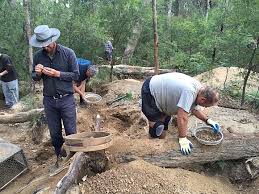 Australia, a land of ancient landscapes and unique wonders, holds a secret deep within its sun-scorched earth: the opal. Known for its mesmerizing “play of colour,” this gemstone is as quintessentially Australian as the kangaroo or the gum tree. For decades, Australia has been the undisputed king of the opal world, supplying over 90% of the globe’s precious opals, including the highly coveted black opal. However, the industry that has built towns and lured dreamers to the outback is now facing a precarious future. A confluence of challenges, from a dwindling workforce to complex regulatory hurdles, has placed this iconic industry at a critical crossroads.
Australia, a land of ancient landscapes and unique wonders, holds a secret deep within its sun-scorched earth: the opal. Known for its mesmerizing “play of colour,” this gemstone is as quintessentially Australian as the kangaroo or the gum tree. For decades, Australia has been the undisputed king of the opal world, supplying over 90% of the globe’s precious opals, including the highly coveted black opal. However, the industry that has built towns and lured dreamers to the outback is now facing a precarious future. A confluence of challenges, from a dwindling workforce to complex regulatory hurdles, has placed this iconic industry at a critical crossroads.
This article will take a detailed look at the forces shaping the Australian opal industry, examining the key issues that threaten its sustainability and exploring the potential pathways forward. We’ll delve into the heart of the matter, from the decline of the independent miner to the intricacies of land access and environmental regulations, to understand what the future holds for this brilliant, and often misunderstood, gemstone.
A Vanishing Breed: The Decline of the Independent Opal Miner

The image of the rugged, independent “gouger” patiently working their claim has long been the romanticized heart of the Australian opal industry. These small-scale operators, often working with a few family members or a small team, are the lifeblood of towns like Coober Pedy, Lightning Ridge, and Andamooka. But this unique workforce is in sharp decline, and the reasons are as complex as the geological formations they mine.
Firstly, the average age of an opal miner is increasing, with very few younger generations entering the trade. Mining is a physically demanding and inherently risky occupation that requires a significant upfront investment in equipment, fuel, and supplies. Without the guarantee of a find, it can be a tough sell for those who can find more stable, higher-paying work in other sectors, such as the flourishing mineral ore and gas industries. This demographic shift means that as the old guard retires, their expertise and experience are not being passed on, leaving a knowledge gap that is difficult to fill.
Furthermore, the high cost of living in remote outback locations, combined with a fluctuating global market for gemstones, makes the financial viability of a mining operation increasingly fragile. A few years of bad luck can be enough to drive a miner out of the industry for good. The lack of a consistent, reliable income stream makes it a high-risk gamble that fewer people are willing to take. This decline in the workforce is arguably the single greatest threat to the industry’s long-term health, as it directly impacts production volume and the discovery of new deposits.
The Maze of Red Tape: Regulatory and Land Access Challenges
For the small-scale miner, navigating the regulatory landscape can feel like an insurmountable challenge. The industry is governed by a patchwork of state-specific regulations, which can be inconsistent and difficult to understand. Recent legislative reviews in places like New South Wales have proposed changes that, while intended to improve sustainability and administration, have been met with fierce opposition from the mining community. These proposals often include increased costs for claims, more stringent environmental levies, and complex rules around land use and rehabilitation.
A significant point of contention is the issue of land access, particularly in areas subject to Native Title agreements. While many Indigenous communities have a long and respectful relationship with the land and its resources, the legal frameworks around mining on Native Title land can be complex and time-consuming. The process of negotiating agreements is often beyond the financial and legal means of the average independent miner, effectively locking them out of potentially rich opal-bearing grounds. The conversion of productive mining land into protected national parks, as has happened in some parts of Queensland, is another blow that reduces the available ground for exploration.
These regulatory hurdles place a heavy administrative and financial burden on miners, diverting their time and resources away from the actual work of mining. They also create a climate of uncertainty, making it difficult for miners to plan for the future or secure financing.
Looking to the Horizon: The Future of the Australian Opal Industry
Despite the significant challenges, the Australian opal industry is far from a lost cause. The future, while uncertain, is not without hope. Several key areas offer opportunities for revitalisation and growth.
One of the most promising avenues is to embrace new technologies and modern business practices. While much of the mining is still done using traditional methods, geological and geophysical exploration techniques are becoming more sophisticated, making it possible to identify new opal deposits with greater precision. Furthermore, the industry can benefit from better marketing and value-added processes. Much of the rough opal mined in Australia is exported overseas for cutting and polishing, meaning the country loses out on a significant portion of the final value. By encouraging more local cutting, polishing, and jewellery creation, the industry can capture more of the value chain.
The global market for opals is also experiencing a resurgence. Rising interest from new markets, particularly in Asia, is driving demand for high-quality, ethically sourced Australian opals. The unique beauty of the stone, with its fire and brilliance, is being rediscovered by a new generation of jewellery designers and consumers. The industry can capitalize on this trend by promoting the stone’s unique story and its connection to the Australian outback.
Finally, there is a clear need for greater collaboration and support for the independent miners who are the backbone of the industry. This includes working with governments to create more flexible and miner-friendly regulations, providing better training and financial support for new entrants, and promoting the industry as a viable and rewarding career path. By addressing the core challenges of workforce decline and regulatory complexity, and by embracing new technologies and market opportunities, the Australian opal industry can secure a bright and prosperous future.
The Road Ahead
The Australian opal industry is at a pivotal moment. The forces of demographic change, economic pressures, and regulatory complexities are putting immense strain on a sector built on the spirit of the independent miner. Yet, the unparalleled beauty and global demand for this unique gemstone provide a powerful reason to believe in its future. The road ahead will require a concerted effort from miners, industry associations, and governments to address the systemic issues and foster a new generation of opal enthusiasts. By doing so, Australia can ensure that the play of colour continues to shine brightly for generations to come, preserving not just a gemstone, but a truly unique piece of its national identity.
